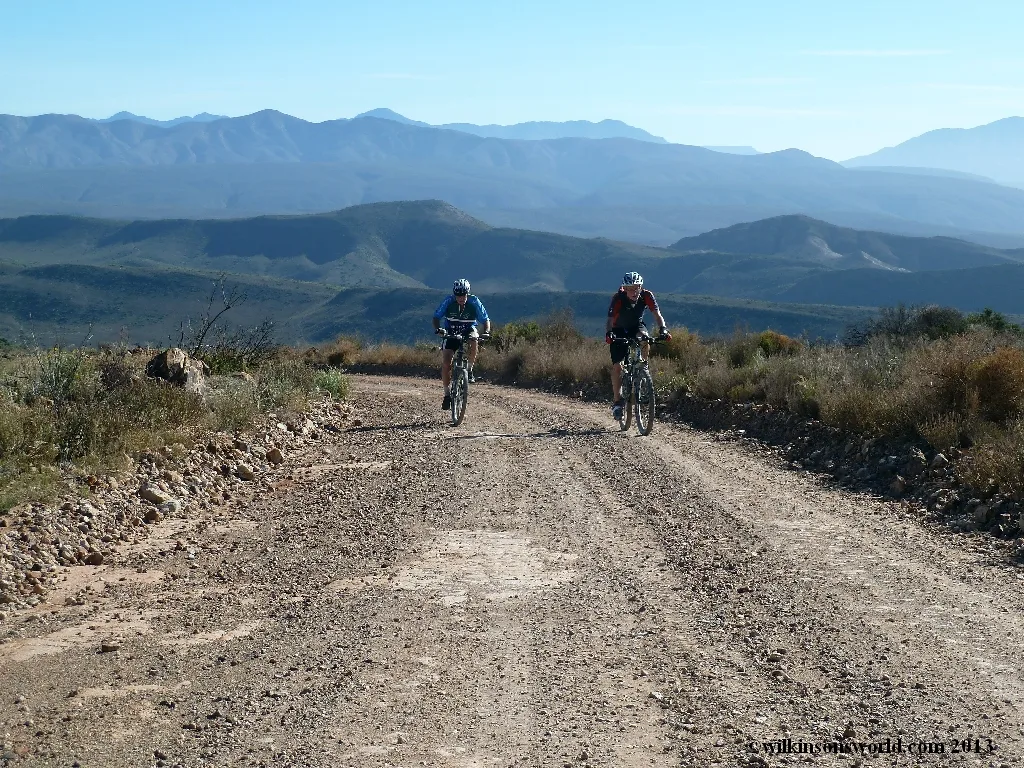To read Part One of this tour, click here.
Day 4: Prince Albert to Calitzdorp
(Approximately 87 km with cumulative climbing of approximately 1664 metres)
Day 4 started with the climb up the Swartberg Pass from the northern side. Although it was still quite cold the day was clear and dry, allowing us to take in the spectacular scenery and spend some time pondering on the engineering skill of Thomas Bain and his co-workers in the construction of the Pass. The road is often supported by packed stone walls as it clings to the side of the Swartberg Mountains and it is amazing that the construction has remained in such magnificent condition for 130-odd years. It was deservedly declared a National Monument in 1988.
In contrast to the ascent from the south on Day 3 we all rode up the Pass this morning and stopped several times to take photographs and to drink in the magnificence of the mountain scenery. It was satisfying to look back at the road snaking up the mountainside, knowing that we had just cycled up that stretch.
After we reached the top (marked by a sign inscribed “Die Top”) and started down the south side of the Pass it became very cold, but today it was dry and we were better prepared for the low temperature. We thoroughly enjoyed the gravity-assisted descent.
Looking back at the Swartberg from the foothills we could see how the cloud had once again descended and were pleased to have crossed the Pass when it was relatively clear.
The ride on to Calitzdorp was very pleasant, on quiet country roads with very little traffic, and with many short uphills and downhills to keep the cycling interesting.
Day 5: Calitzdorp to Cloete’s Pass
(Approximately 117 km with cumulative climbing of approximately 2145 metres)
The “Pass of the Day” today was the Rooiberg Pass, although the day would also include a tough climb up from the Gouritz River, and end with the ascent of Cloete’s Pass.
The Rooiberg Pass over the Gamkasberg was built in 1928 to provide a link between Calitzdorp and Van Wyksdorp. This Pass provides a steady climb over several kilometres, but the gradient is not too challenging and there was time for us to take in the diverse vegetation of the Rooiberg Conservancy. This conservancy forms part of the Gouritz Biodiversity Meander, a world biological “hotspot” where three biomes meet – Succulent Karoo, Fynbos and Subtropical Thicket. We stopped several times to look back in wonder at the spectacular mountain scenery behind us.
At the top of the Pass is a cairn of stones left by travellers over many, many years in thankful tribute for a safe passage up the mountain, and in the hope of an equally safe descent. The spot is marked by a plaque erected in 1984. One is inclined to overlook the challenge that these Passes presented to travellers in animal drawn wagons a century ago and the thankful prayers that were offered up for a safe arrival at this spot.
We each placed a stone on the cairn before starting the descent to Van Wyksdorp through the scrubland of the Little Karoo.
After a quick lunch in Van Wyksdorp we continued riding and soon reached the descent to the Gouritz River. This stretch provided still more views of the wide open country, covered with the low shrubs and grasses typical of the area. The climb up from the Gouritz River is steep and testing for legs that were growing weary from the days on the road. But there was to be little respite, as the day ended with the climb up Cloete’s Pass which we reached shortly before dusk, when the temperature was taking its usual evening plunge.
Just two kilometres into the descent of Cloete’s Pass we reached Dwarsrivier Country Getaway, our overnight stop at the end of the longest day of the tour.
Day 6: Cloete’s Pass to George
(Approximately 91 km with cumulative climbing of approximately 1164 metres)
The final day of the tour turned out to be surprisingly difficult! The day started with the easy descent of the balance of Cloete’s Pass, but we were immediately challenged by the sharp climb up from the river on a road surfaced with loose gravel and small stones. This stretch also provided what was surely the steepest descent, and the steepest ascent, of the tour. The descent was fairly short, but very steep and I was glad not to be riding in the opposite direction, only to find a matching ascent on reaching the valley.
The road continued in a series of ups and downs, not rolling hills at all, but serious ascents and descents. We by-passed Eight Bells, tempted to stop for tea, but the cycling was more urgent today, the group keen to reach the end. The stops were short and less frequent, and the pace somewhat quicker.
After lunch in a park near the Great Brak River, we pressed on over the last, fairly flat 20km to George and the end of a wonderful tour.









Recent Comments